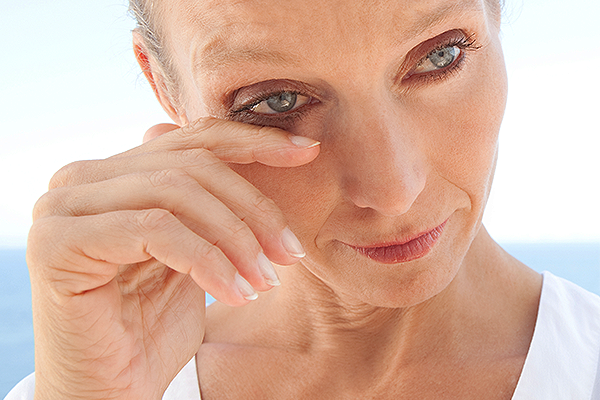Many of us think occasional dry eye is a natural part of aging, and so we do nothing about it.


Following menopause, however, our hormone fluctuations can disrupt our eye health. FOF recently spoke with Sean Mulqueeny, O.D. of Mulqueeny Eye Centers in St. Louis, to get the low-down on the relationship between occasional dry eye and menopause.
![]()
What happens during menopause that can cause occasional dry eye?
A disruption or imbalance of hormones can lead to increased surface inflammation in all patients older than 50. While increased dryness occurs in both genders past age 50, dry eye is nearly twice as likely to occur in women. A decrease of the hormone androgen can cause your eyes to lose moisture.
How can a woman tell if she has dry eye, without seeing a doctor?
The most common dry eye complaint is vision fluctuation. Patients describe difficulty in keeping objects in focus and transient blurring, especially while reading or working on the computer. This can also lead to eye fatigue and eyestrain. Another hallmark of progressive dry eye is an increased intolerance to contact lenses. Some people even have to stop wearing contact lenses entirely.
Why is occasional dry eye often ignored as a menopause symptom, when our vision is so important?

I’ve found in my discussions with menopausal women that many consider dry eye a normal part of aging, with no remedies. This is why we perform dry eye screenings of all women over the age of 40 in our office. We educate every at-risk patient about the symptoms of dry eye and about the many treatment options available.
What easy treatment options are available for this condition?
Oral supplements for occasional dry eye can help treat the underlying source of dry eye inflammation, whereas artificial tears only provide temporary relief.
What happens if a woman doesn’t treat her dry eye? Is she more prone to infections?
While there’s always the nuisance factor associated with dry eye, there’s an increased risk of infection as dry eye progressively worsens. Extreme cases can lead to significant pain and a decreased quality of life. The most severe cases can result in scarring of the cornea (the clear front wall of the eye) and permanent sight loss.
![]()
Click here to learn more about a way to improve your occasional dry eye and support your long-term eye health.
This post is sponsored by EyePromise. Thanks for supporting FabOverFifty!

